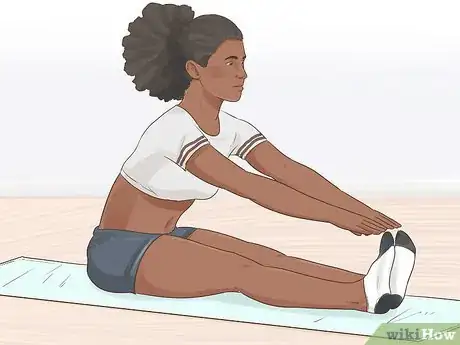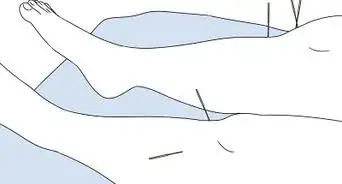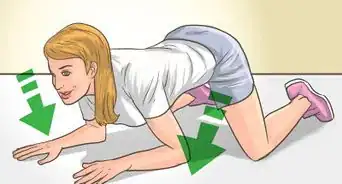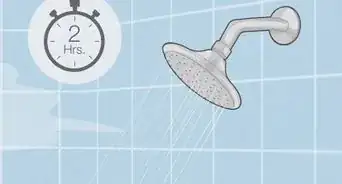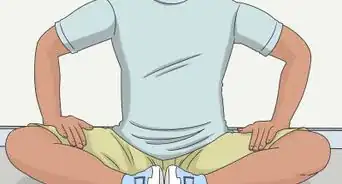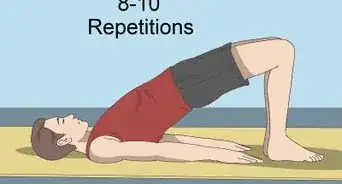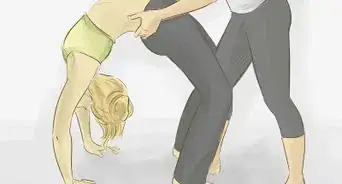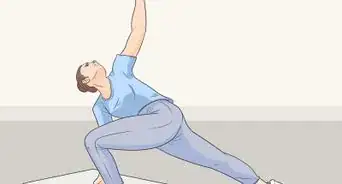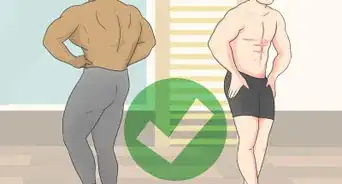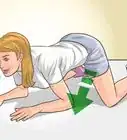This article was co-authored by Monica Morris. Monica Morris is an ACE (American Council on Exercise) Certified Personal Trainer based in the San Francisco Bay Area. With over 15 years of fitness training experience, Monica started her own physical training practice and gained her ACE Certification in 2017. Her workouts emphasize proper warm-ups, cool-downs, and stretching techniques.
There are 12 references cited in this article, which can be found at the bottom of the page.
This article has been viewed 160,874 times.
Improving your leg flexibility is a great way to start getting in shape, or can help prevent serious injuries if you’re already an experienced athlete. Stretching out the legs can also have positive impacts on your back, ability to perform daily tasks, and overall health.[1] Whether you’re just getting started on a fitness regimen or want to impress your friends with splits, the key to stretching is keeping up with a regular routine three to four times a week. By stretching regularly, and combining poses that target your quads, hamstrings, calves, and hips, you’ll find yourself becoming more flexible with each passing week.
Things You Should Know
- The best way to improve your leg flexibility is by doing leg stretches 3-4 times a week.
- The butterfly stretch, short bridge stretch, and standing calf stretch are a few great leg stretches to incorporate into your routine.
- Yoga poses like downward dog and easy pose can also help improve your leg flexibility.
- Stretching shouldn't hurt. If you feel pain, stop.
Steps
Learning Basic Stretches
-
1Start off with the “easy pose.” Sit on one or two folded blankets with your legs stretched in front of you. Bring your legs in and sit cross-legged, and make sure your knees aren’t at a level any higher than your hips (sitting on the blankets will help with this). Don’t let your chest sink down: hold your chest out and pull your shoulders back.[2]
- Hold this pose for several minutes, and feel the stretch working through your quads, hips, and lower back.
- Alternate the pose: switch up which shin is crossed in front of the other.
- It might seem too simple to just sit crossed-legged, but this pose is an excellent way to get your stretching routine started.
-
2Do the butterfly stretch. While sitting, bend your knees and bring the soles of your feet together. Drop your knees as far to the floor as possible. Don’t force your knees, but open where your thighs and hips meet and allow these two joints to work together toward the floor. Bring your heels in toward your pelvis as far as is comfortable.[3]
- Keep stretching for 30 seconds, continuing to breathe as you do so.
- As in the easy pose, lengthen your chest and keep the shoulders back.
- Use your breathing to control the stretch. Feel the stretch work through your inner and upper thighs, hamstrings, buttocks, and lower back.
Advertisement -
3Reach for your toes. Sit on the floor with your legs together in front of you. If possible, keep the back of your knees to the floor. Inhale, and flex your feet by drawing your toes toward your torso. Exhale, and reach for your toes with your hands, keeping your back and core straight.
- Sit against a wall with a towel rolled between the wall and your lower back if you need support.
-
4Do the short bridge stretch. Lay on your back with your arms flat by your sides, knees bent, and your feet flat on the floor shoulder distance apart. Inhale slowly; as you exhale, lift your buttocks by pressing your arms and feet into the floor, tucking your sternum to your chin as you lift. Your buttocks and thighs should be parallel to the floor, and your knees should be directly over your heels and bent at a 90 degree angle.[4]
- The short bridge is a great beginner flexibility exercise that stretches the lower back and quads, and strengthens the buttocks and hamstrings.[5]
- Hold the pose for 5 seconds as you slowly exhale, then inhale as you come back to the floor. Keep breathing slowly and hold the pose for 30 seconds to a minute if you’re able.
- Use a yoga mat if you have one, and place a rolled up towel under your neck if it makes you more comfortable.
- Avoid this pose if you have recently injured your back or neck, unless your doctor, physical therapist, or chiropractor recommends it.
Targeting the Quadriceps
-
1Stretch your quads while standing. Stand with your legs in line with your shoulders. Keep your back straight and bend your knee to lift your shin and foot behind you. Reach back and hold the toe of the leg you’re lifting to extend the stretch further. Hold the stretch for 5 to 10 seconds, depending on your ability.[6]
- Use your hand on the same side as the leg you’re lifting: if you’re lifting your left leg, use your left hand.
- Brace yourself by holding your opposite hand against a wall if you need help balancing.
- Repeat on the other side, and proceed to 5 to 10 repetitions for each leg.
-
2Try a kneeling bridge stretch. Kneel down and sit on your heels. Reach behind you and place your hands on the ground with your arms fully extended. Inhale, then place your weight on your hands and exhale as you tighten your buttocks and lift your pelvis forward off of your heels.[7]
- Hold the pose for 3 to 5 seconds, depending on your ability, then return to the seated position. Proceed with at least 10 repetitions.
- The farther back you reach, the more intense your stretch. Start with your hands closer to your feet if you're a beginner.
-
3Do lunge stretches. Start on one knee with your other leg forward, so that knee is bent above the heel at a 90 degree angle. Bring both hands to your forward thigh, and lean your torso backward while extending that knee forward. Use these opposite motions to stretch out your quad.[8]
- Hold for thirty seconds. Proceed with 5 to 10 repetitions on each leg.
- Work the stretch even more by sliding the foot that's flat on the ground slightly outward and bringing both hands to the floor. Your arms and hands should be on the inner side of your leg and your knee should be in line with your shoulder. Bend your elbows, bringing them closer to your chest as you lower your torso closer to the floor.[9]
Stretching the Hamstrings and Calves
-
1Do the standing calf stretch. Stand facing a wall with your arms extended and hands held flat against the wall. Your legs should be shoulder distance apart, with one leg extended behind you and feet flat on the floor. Bend your forward knee and lean toward the wall while keeping your back straight, feeling the stretch work through the calves and hamstrings of your back, extended knee.[10]
- Hold this pose for 30 seconds to a minute, and repeat on the other leg. Proceed with 5 to 10 repetitions for each leg.
-
2Do the downward dog. Get on all fours with your hands under your shoulders with your knees bent under your hips and held apart at shoulder distance. Spread your fingers apart for wide support and walk your hands slightly forward. Bring your hips up toward the ceiling as you tighten your core muscles.[11]
- Try to keep your heels close to or on the ground, and feel the stretch work through your calves as you keep your knees straight.
- Hold the pose for thirty seconds to a minute, or longer if you’re able to do so. Proceed with 5 to 10 repetitions.
- Try bending one knee at a time while keeping your toes in place to extend the stretch through your hamstrings.
-
3Try the “heavy leg” pose. Start by laying on your back with your buttocks facing a wall. Tuck yourself as close to the wall as you can, and bring your legs straight up against the wall. Keep them as straight as possible, so your torso on the floor and your legs against the wall form a 90 degree angle. Flex your feet by stretching your toes toward your torso, and feel the stretch work through the backs of your legs.[12]
- Try to hold the pose for 2 to 3 minutes.
- If you have an elastic strap, try looping it over your feet and hold each end in your hands to increase the stretch.
Expert Q&A
Did you know you can get expert answers for this article?
Unlock expert answers by supporting wikiHow
-
QuestionHow do you loosen tight leg muscles?
 Monica MorrisMonica Morris is an ACE (American Council on Exercise) Certified Personal Trainer based in the San Francisco Bay Area. With over 15 years of fitness training experience, Monica started her own physical training practice and gained her ACE Certification in 2017. Her workouts emphasize proper warm-ups, cool-downs, and stretching techniques.
Monica MorrisMonica Morris is an ACE (American Council on Exercise) Certified Personal Trainer based in the San Francisco Bay Area. With over 15 years of fitness training experience, Monica started her own physical training practice and gained her ACE Certification in 2017. Her workouts emphasize proper warm-ups, cool-downs, and stretching techniques.
ACE Certified Personal Trainer Stretch regularly to make your everyday activities easier. The reason your legs can get really tight is because your hips and groin are a really intricate system of different tendons, joints, cartilage, bone, and muscle. It's the moving force behind all of the moving, lifting, and walking you do throughout the day, and it really needs to be stretched thoroughly.
Stretch regularly to make your everyday activities easier. The reason your legs can get really tight is because your hips and groin are a really intricate system of different tendons, joints, cartilage, bone, and muscle. It's the moving force behind all of the moving, lifting, and walking you do throughout the day, and it really needs to be stretched thoroughly. -
QuestionHow can I improve my leg flexibility for splits?
 Monica MorrisMonica Morris is an ACE (American Council on Exercise) Certified Personal Trainer based in the San Francisco Bay Area. With over 15 years of fitness training experience, Monica started her own physical training practice and gained her ACE Certification in 2017. Her workouts emphasize proper warm-ups, cool-downs, and stretching techniques.
Monica MorrisMonica Morris is an ACE (American Council on Exercise) Certified Personal Trainer based in the San Francisco Bay Area. With over 15 years of fitness training experience, Monica started her own physical training practice and gained her ACE Certification in 2017. Her workouts emphasize proper warm-ups, cool-downs, and stretching techniques.
ACE Certified Personal Trainer Try a straddle stretch to open your hips. A straddle stretch is one of the best ways to improve the flexibility in your legs, and it's exactly what it sounds like—a stretch where you straddle the floor. To do it, get down on your knees and open your knees to about 2 1/2 feet wide. Then, fit your pelvic girdle down toward your right leg and shift your hips to push down that way. Then, slide over to your left leg, and continue going back and forth.
Try a straddle stretch to open your hips. A straddle stretch is one of the best ways to improve the flexibility in your legs, and it's exactly what it sounds like—a stretch where you straddle the floor. To do it, get down on your knees and open your knees to about 2 1/2 feet wide. Then, fit your pelvic girdle down toward your right leg and shift your hips to push down that way. Then, slide over to your left leg, and continue going back and forth. -
QuestionCan I stretch my hamstrings every day?
 Monica MorrisMonica Morris is an ACE (American Council on Exercise) Certified Personal Trainer based in the San Francisco Bay Area. With over 15 years of fitness training experience, Monica started her own physical training practice and gained her ACE Certification in 2017. Her workouts emphasize proper warm-ups, cool-downs, and stretching techniques.
Monica MorrisMonica Morris is an ACE (American Council on Exercise) Certified Personal Trainer based in the San Francisco Bay Area. With over 15 years of fitness training experience, Monica started her own physical training practice and gained her ACE Certification in 2017. Her workouts emphasize proper warm-ups, cool-downs, and stretching techniques.
ACE Certified Personal Trainer
Warnings
- It’s always best to consult your doctor or medical professional before undertaking any exercise routine, especially if you have risk factors such as cardiovascular or heart issues.⧼thumbs_response⧽
- If it hurts, then stop: listen to your body. Otherwise, you’ll risk straining or tearing muscles.⧼thumbs_response⧽
References
- ↑ http://diet.mayoclinic.org/diet/move/flexibility-better-health
- ↑ http://www.yogajournal.com/pose/easy-pose/
- ↑ http://www.yogajournal.com/pose/bound-angle-pose
- ↑ https://www.youtube.com/watch?v=hKAl-jcRzWM&feature=youtu.be&t=69
- ↑ https://www.12minuteathlete.com/bridges/
- ↑ http://www.physioadvisor.com.au/exercises/flexibility-muscles-2/quadriceps/
- ↑ https://www.youtube.com/watch?v=f3NTWOzf8rw&feature=youtu.be&t=160
- ↑ https://www.youtube.com/watch?v=lFU53cWp068&feature=youtu.be&t=16
- ↑ https://www.youtube.com/watch?v=lFU53cWp068&feature=youtu.be&t=57
- ↑ http://www.stretching-exercises-guide.com/calf-stretches.html
- ↑ http://www.stretching-exercises-guide.com/calf-stretches.html
- ↑ http://www.espn.com/espnw/training/article/16652890/5-yoga-poses-improve-hamstring-flexibility
- ↑ http://www.mayoclinic.org/healthy-lifestyle/fitness/in-depth/stretching/art-20047931?pg=2
About This Article
To improve your leg flexibility, start with simple stretches. Sit on a folded blanket with your legs crossed in front of you and your knees at hip level or lower. Hold the pose for several minutes to get a light stretch in your quads and hips. Next, try a butterfly stretch. Sit on the floor and press the soles of your feet together in front of you, then drop your knees as close to the floor as you can. Hold the stretch for at least 30 seconds while breathing deeply. When you’re done, stretch your legs straight out in front of you and flex your feet back toward your body. While keeping your back straight, reach out and try to touch your toes. Finally, lie on your back with your knees bent and your feet on the floor. Keep your hands flat at your sides and push your hips and thighs off the floor to do a short bridge. Hold the pose for 5 seconds while you exhale, then inhale as you lower down to the floor. For more tips from our Personal Training co-author, including how to do lunge stretches, read on!


